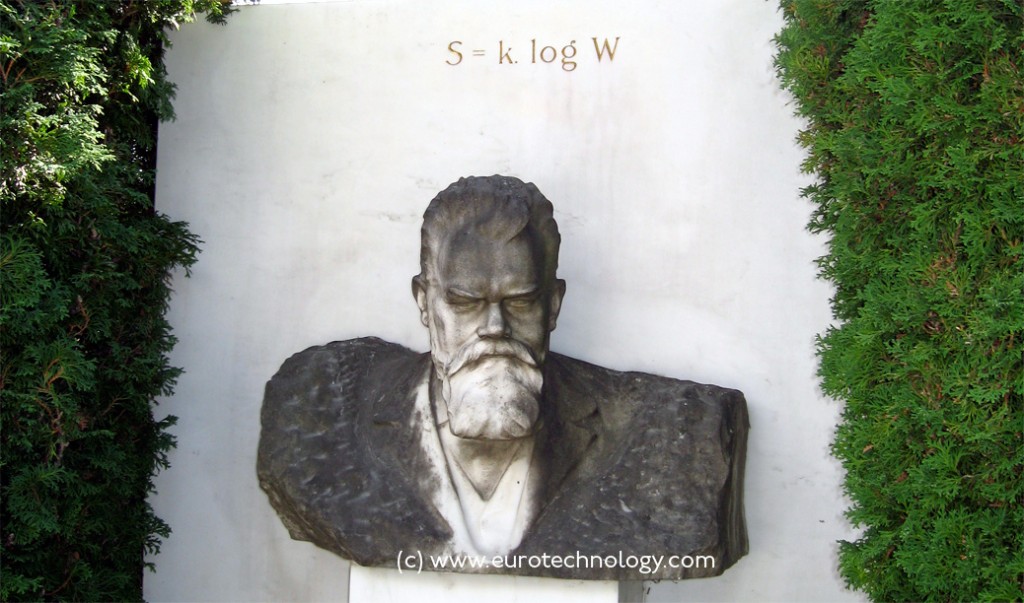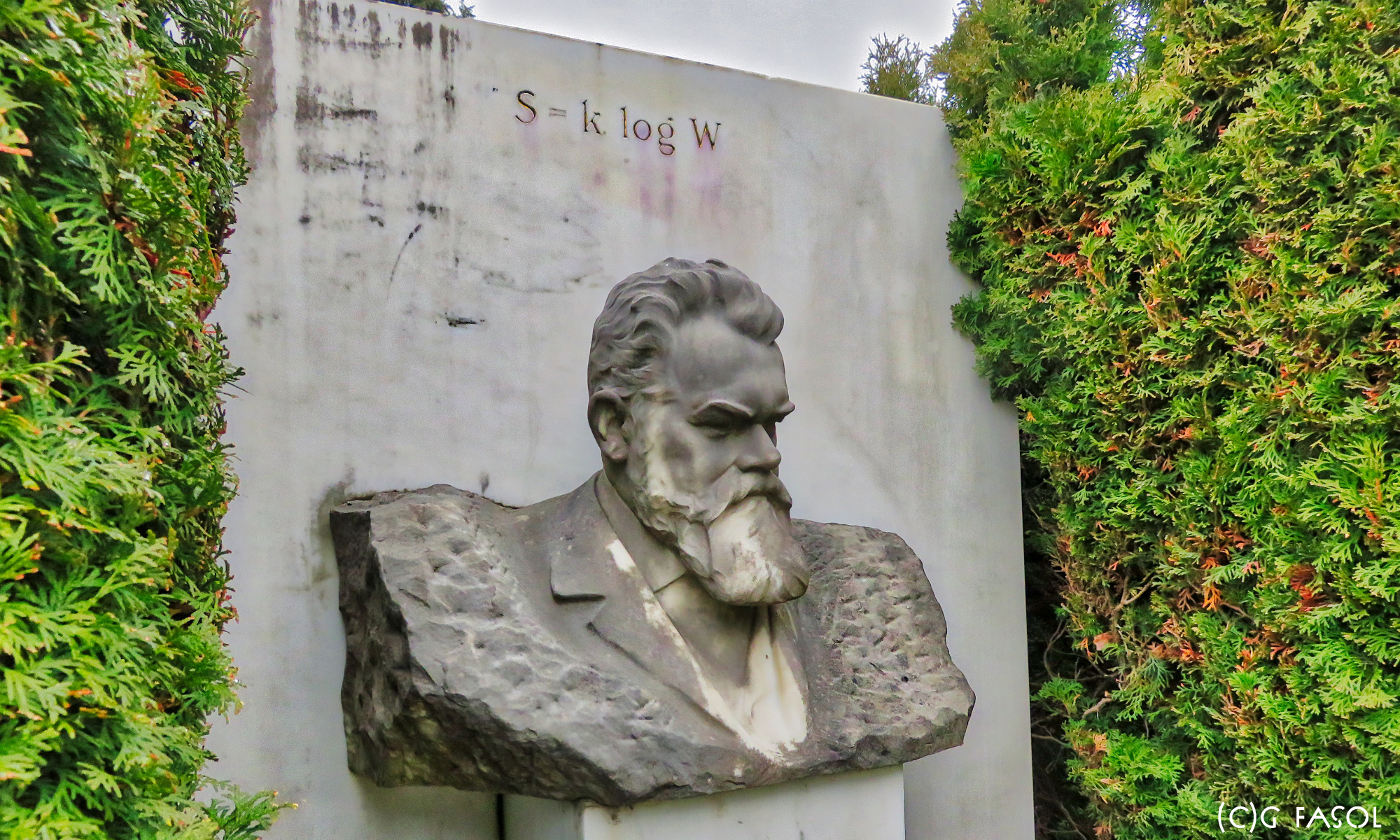The Boltzmann constant k links temperature with energy, and entropy with probability, and links the macroscopic and the microscopic worlds
author of this page: Gerhard Fasol
In the new SI system the value of the Boltzmann constant k is defined as exactly k= 1.380 649. 10^-23 J / K or k= 8.617 333 262 . 10^-5 eV / K
The Boltzmann constant relates the average kinetic energy for each degree of freedom of a physical system in equilibrium to its temperature. As an example, the Boltzmann constant relates the average kinetic energy of particles in a gas with the temperature of the gas.
Boltzmann constant k links temperature with energy
In an ideal gas in equilibrium at temperature T, the average kinetic energy per molecule is:
1/2 m<v^2> = 3/2 kT, where k is Boltzmann’s constant.
More generally in a classical system of particles, observing Boltzmann statistics, oscillators etc. the average energy in equilibrium per degree of freedom is 1/2 kT.
Note that there are other systems observing Bose-Einstein, or Fermi-Dirac statistics where other relationships apply.
Boltzmann constant k links entropy with probability
For an isolated system of particles in equilibrium, entropy S is the natural logarithm of W (W stands for the German word “Wahrscheinlichkeit” = probability), the number of possible micro-states for the given macroscopic properties (e.g. temperature, pressure, number of atoms/molecules etc):
S=k ln W
Thus Boltzmann constant k has the dimensions Energy/Temperature.
Thus Boltzmann constant k bridges macroscopic physics (temperature, entropy) with microscopic physics (average energy of particles/atoms/molecules, number of micro-states, probability of micro-states).
The Boltzmann constant k bridges macroscopic and microscopic (atomic, molecular) physics
The Boltzmann constant also appears in many other contexts in physics. As an example, Boltzmann’s famous law S = k . log W, relates the entropy S to the logarithm of the probability of a particular macro-state, thus links the macroscopic entropy to the microscopic probability of a system.
On 16 November 2018 the Boltzmann constant switched from an experimentally determined quantity to a fixed value as one of seven “defining constants”
Previous to 16 November 2018, the Boltzmann constant k was experimentally determined, and depended on the definition of the unit of temperature Kelvin, which was defined in relation to the triple point of “Vienna Standard Mean Ocean Water” (VSMOW). The previous best value of Boltzmann’s constant was the 2017 CODATA value:
k = 1.380 648 52 . 10-23 JK-1, and the standard uncertainty is:
su = 0.000 000 79 . 10-23 JK-1
This approximate value for the Boltzmann constant k is historic, and by reconstruction of the SI System of units not accurate any longer today.
Today’s value is exactly:
k= 1.380 649. 10^-23 J / K
or
k= 8.617 333 262 . 10^-5 eV / K
see for example NIST website:
https://physics.nist.gov/cgi-bin/cuu/Value?k
Fundamental constants and the SI system of units:
Each fundamental constant Q is a product of a number {Q} and a base unit [Q]:
Q = {Q} x [Q],
for example Boltzmann’s constant is:
k = 1.380 649 x 10-23 JK-1.
Thus we have two ways to define the SI system of SI base units:
- we can fix the units [Q], and then measure the numerical values {Q} of fundamental constants in terms of these units (method to define the old SI system)
- we can fix the numbers {Q} of fundamental constants, and then define the units [Q] thus that the fundamental constants have the numerical values {Q} (method of defining the new SI system)
Boltzmann constant k and the new framework for the SI system of units:
With the 26th General Conference on Weights and Measures (CGPM) on 16 November 2018 the SI system of units switched from the previous method (1.) where units are fixed and numerical values of fundamental constants are “variable”, i.e. determined experimentally, to the new method (2.) where the numerical values of the set of fundamental constants is fixed, and the units are defined such, that their definition results in the fixed numerical values of the set of fundamental constants. This switch to a new definition of the SI system requires international agreements, and decisions by international organizations, and this process was completed on 16 November 2018.
Boltzmann constant k and the SI unit for temperature Kelvin:
The method used previous to 16 November 2018 (1.) above was problematic: The SI unit of temperature, Kelvin was defined as the fraction 1/273.16 of the thermodynamic temperature at the triple point of water. The problem was that the triple point depends on many factors including pressure, and the precise composition of water, in terms of isotopes and impurities. In the old definition the water to be used is determined as “VSNOW” = “Vienna Standard Mean Ocean Water“. Of course this is highly problematic, and the new method (2.) does not depend on VSNOW any longer.
In the new system (2.) the Kelvin is defined as:
Kelvin is defined such, that the numerical value of the Boltzmann constant k is equal to exactly 1.380 649 x 10-23 JK-1.
Measurements of Boltzmann constant k:
In order to link the fixed numerical value of Boltzmann’s constant to the previous definitions of the Kelvin, and in particular to determine the precision and errors, it is necessary to measure the value of Boltzmann’s current in terms of SI units as accurately as possible, and also to understand and estimate all errors in the measurement. Several measurements of Boltzmann’s constants are being performed in laboratories around the world, particularly at several European and US laboratories.
Dr Michael de Podesta, National Physical Laboratory (NPL), UK
Arguably today’s best measurement has been performed by Dr Michael de Podesta MBE CPhys MInstP, Principal Research Scientist at the National Physical Laboratory NPL in Teddington, UK, who has kindly discussed his measurements and today’s status of the work on the system of SI units and its redefinition with me, and has greatly assisted in the preparation of this article. Dr Podesta’s measurements of Boltzmann’s constant have been published in:
Michael de Podesta et al. “A low-uncertainty measurement of the Boltzmann constant”, Metrologia 50 (2013) 354-376.
Dr Podesta’s measurements are extremely sophisticated, needed many years of work, and cooperations with several other laboratories. Dr. Podesta and collaborators constructed a highly precise resonant cavity filled with Argon gas. Dr. Podesta measured both the microwave resonance modes of the cavity to determine the precise radius and geometry, and determined the speed of sound in the Argon gas from acoustic resonance modes. Dr Podesta performed exceptionally accurate measurements of the speed of sound in this cavity, which can be said to be the most accurate thermometer globally today. The speed of sound can be directly related to 3/2 k.T, the mean molecular kinetic energy of the Argon molecules. In these measurements, Dr. Podesta very carefully considered many different types of influences on his measurements, such as surface gas layers, shape of microwave and acoustic sources and sensors etc. He achieved a relative standard uncertainty of 0.71. 10-6, which means that his measurements of Boltzmann’s constant are estimated to be accurate to within better than on millionth. Dr. Podesta’s measurements directly influences the precision with which we measure temperature in the new system of units.
Over the last 10 years there was intense effort in Europe and the USA to build rebuild the SI unit system. In particular NIST (USA), NPL (UK), several French institutions and Italian institutions, as well as the German PTB (Physikalische Technische Bundesanstalt) have undertaken this effort.
Boltzmann constant k – today’s fixed value
With the new SI system of physical units, since 16 November 2018, the value of the Boltzmann constant k is fixed as:
k = 1.380 649 . 10-23 JK-1

Copyright (c) 2014-2024 Eurotechnology Japan KK All Rights Reserved
